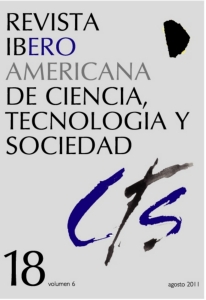“Glass ceiling” and “sticky floor”
Women’s situation in the German and Spanish science and technology systems
DOI:
https://doi.org/10.52712/issn.1850-0013-746Keywords:
science, gender, glass ceiling index, sticky floor, Germany, SpainAbstract
Germany is the fifth world economy and the first in Europe. It is recognized as a leader in science and technology sectors and it is the country with the second highest R&D expenditure in the European Union. However, it is one of the worst European countries regarding science and gender. The researchers not only face a glass ceiling, but also a sticky floor that illustrates the difficulties faced by women graduates in entering the early stages of an academic career. This paper analyzes the situation of women in the German system and compares it with the Spanish case. Corrected Spanish data are also presented, since those supplied by the INE to the European Commission were wrong. Finally, we recalculate the glass ceiling index and present a brief analysis of the formula used for the calculation.
Downloads
References
BALLARÍN, P. (1994): “La construcción de un modelo educativo de utilidad doméstica”, en FRAISSE, G. y PERROT, M.: Historia de las mujeres. El siglo XIX, Barcelona: Círculo de Lectores.
BLK (2000): Frauen in der Wissenchaft. Entwicklung und Perspektiven auf dem Weg zur Chancenafeichheit.
BOCK, G. (1994): “Políticas sexuales nacionalsocialistas e historia de las mujeres” en en FRAISSE, G. y PERROT, M.: Historia de las mujeres. El siglo XIX, Barcelona: Círculo de Lectores.
BROKMAN-NOOREN, C. (1999): Weibliche Bildung im 18. Jahrhundert: »gelehrtes Frauenzimmer« und »gefällige Gattin«, Tesis doctoral, Publicación electrónica Oldenburg Universität, http://oops.uni-oldenburg.de/frontdoor.php?source_opus=691.
CANALES, A. (2006): “Las mujeres y la enseñanza científico tecnológica en la España del Siglo XX”, Clepsidra, Nº 5, pp. 111-127.
DOFF, S. (2005): Wiblichkeit und Bildung: Ideengeschichtliche Grundlage für die Etablierung des höheren Mädchenschulwesen in Deutschland, en Goethezeitportal http://www.goethezeitportal.de/fileadmin/PDF/db/wiss/epoche/doff_weiblichkeit.pdf.
EUROPEAN COMMISSION (2009): She figures 2009, Directorate General for Research, Science and Society.
FISCHER, T. (2002): “Die Aufänge des Frauenstudiums um 1900” en KÖCK, J. y MERTENS, E.: Eine Dame Zwischen 500 herren: bhanna Mestorf, Werk und Wirkung, Münster: Ed. Waxman Verlag.
FLECHA, C. (1996): Las primeras universitarias en España 1872-1910, Madrid: Ed. Narcea.
GÓMEZ, A. et al. (2008): “Sesgos de género en la educación científico tecnológica: el caso de la Universidad de la Laguna”, Arbor, Nº 733, pp. 935-947.
GONZÁLEZ, M. y SEDEÑO, E. (2002): “Ciencia, tecnología y género”, Revista Iberoamericana de Ciencia, tecnología, sociedad e innovación, Nº 2.
HADULLA_KUHLMAN, C. y HARTUNG, B. (2002): “Women and science: review of the situation in Germany”, en http://ec.europa.eu/research/science-society/pdf/womennationalreportgermany. pdf
HOOCK DEMARLE, M. C. (1994): “Leer y escribir en Alemania”, en FRAISSE, G. y PERROT, M.: Historia de las mujeres. El siglo XIX, Barcelona: Círculo de Lectores.
HRK (2006): Hochschulrektorenkonferenz, “Frauen fördem”, en http://www.hrk.de/de/download/dateien/Empfehlung_Frauen.pdf.
MARTELL, R., LANE, D. y EMRICH, C. (1996): “Male-female Differences: A Computer Simulation”, American Psychologist, pp. 157-158.
NEUBAUER, S. (2007): “Studentinnen im Nationalsozialismus an der Universität Tübingen”, en 100 Jahre Frauenstudium an der Universität Tübingen 1904 - 2004, Universität Tubingen, http://tobias-lib.uni-tuebingen.de/volltexte/2007/2723/pdf/100JahreFrauenstudiumPublikationsendfassung.pdf.
OCDE (2003): Manual de Frascati, Madrid, Fundación Española para la Ciencia y la Tecnología (FECYT).
OPOCE (2003): Third European Report in Science and Technology Indicators-Towards a Knowledge-based Economy, Luxemburgo.
PÉREZ SEDEÑO, E. et al. (2005): La situación de las mujeres investigadores en el sistema español de ciencia y tecnología, Madrid: FECYT.
PÉREZ SEDEÑO, E. et at.: La situación de las mujeres en el sistema de ciencia y tecnología en España y su contexto internacional, Programa de análisis y estudios de acciones destinadas a la mejora de la calidad de la enseñanza superior y de actividades del profesorado universitario (Ref: S2/EA2003-0031).
POZO RUIZ, A.: “Mujer y educación en el siglo XIX”, en http://personal.us.es/alporu/historia/mujer_educacion.htm.
THE MEMORY OF AACHEN UNIVERSITY: “Pionierinnen der Wissenschaft - Frauen an den Universitäten”, en http://www.archiv.rwth-achen.de/onlinepionierinnen/objektevitrine1.htm.
VÁZQUEZ RAMIL, R.: La Institución Libre de Enseñanza y la Educación de la Mujer en España: La Residencia de Señoritas (1915-1936), tesis doctoral, en http://webs.uvigo.es/pmayobre/colaboraciones.htm#raquel_vazquez_ramil.
Downloads
Published
How to Cite
Issue
Section
License
Copyright (c) 2024 CC Attribution 4.0

This work is licensed under a Creative Commons Attribution 4.0 International License.
All CTS's issues and academic articles are under a CC-BY license.
Since 2007, CTS has provided open and free access to all its contents, including the complete archive of its quarterly edition and the different products presented in its electronic platform. This decision is based on the belief that offering free access to published materials helps to build a greater and better exchange of knowledge.
In turn, for the quarterly edition, CTS allows institutional and thematic repositories, as well as personal web pages, to self-archive articles in their post-print or editorial version, immediately after the publication of the final version of each issue and under the condition that a link to the original source will be incorporated into the self-archive.











